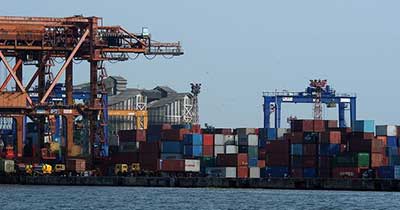Relevance: GS-2: Bilateral, regional and global groupings and agreements involving India and/or affecting India’s interests.
Key Phrases: comprehensive trade agreement, interim/early harvest Trade agreement, WTO law, Regional Trade Agreements (RTAs), liberalise tariff/market access, India-Japan CEPA, Article XXIV of GATT, full-fledged FTA, Free Trade Agreement.
Why in News?
- India is looking to tap into the global demand through fast-tracking interim or early harvest agreements with the developed world.
Context:
- International commercial relations are set to get re-oriented post the pandemic. Opportunities for a quality producing market with reliable supply chains are abound, and it is here that India scores with its cost-effective production, accelerating growth and huge skilled workforce.
- No wonder our exports are increasing and we are very much on track to hit $400 billion in this financial year. The government, on its part, has been smoothening trade processes for quite some time now and is engaged in talks towards forward looking trade agreements.
- With export facilitation and deeper market access as aim, we have just concluded a comprehensive trade agreement with the UAE (in record time) and are in line for a trade pact with Australia (UK, EU, and recently announced Canada FTAs to follow). Further, as per the news reports, a trade pact with Australia could be as early as this month and is likely to be in the form of an interim/early harvest trade agreement.
Article XXIV of the General Agreement on Tariffs & Trade (GATT):
- An exception provided within the WTO law, this article allows WTO members to deepen trade ties bilaterally or among a group of members, on preferential basis. The resultant preferential agreements are known through different nomenclatures viz. Free Trade Agreements (FTAs), Regional Trade Agreements (RTAs), Preferential Trade Agreements (PTAs), etc.
- In general, these trade agreements liberalise tariff/market access for trade in goods or in some cases also in services. Such agreements for the past decade or so, however, have extended their facilitation mandate by including alternate tracks beyond goods and services, such as investment (India-Japan CEPA is an example).
- In spite of whatever they are called, all such full-fledged agreements under Article XXIV are required to be notified to the WTO and should cover “substantially all the trade” in products originating in the territories of the contracting parties.
- Here in lies a catch. While such trade agreements cover substantial liberalisation (what is ‘substantial’ remains undefined), they may take considerable time, especially if the negotiating parties are competing in or are sensitive towards certain “must-haves” of each other.
- This gets exacerbated by the fact that today’s agreements go beyond existing national commitments in the WTO and cover many areas that are hitherto uncovered in multilateral trade rules — investment, intellectual property rights, competition, e-commerce, to name a few.
- The resulting deep and comprehensive market integration necessarily requires prolonged negotiations and are time consuming (most modern FTAs have more than a dozen different tracks). Thus, many WTO member countries are not able to make benefits available to their industry and consumer on an immediate basis despite best intentions.
Article XXIV of GATT: Territorial Application – Frontier Traffic – Customs Unions & Free Trade Areas Conditions and measures relating to the formation of customs unions and free trade areas by Members.
Alternative approaches
- The drafters of GATT however provided an alternative way of approaching such trade negotiations. Though largely unused, this approach enables early harvesting of the agreed provisions in the form of an interim agreement, while the negotiations continue for a comprehensive trade pact (para 5 of Article XXIV).
- The said provision thus provides a tool to the negotiating countries to lower tariffs on some goods and take other steps in anticipation of a full FTA. As a result, such an agreement can be quickly negotiated and most importantly, harvested, for the benefit of the trade. As an example, consider two WTO members ‘A’ — a developed country and ‘B’ — a developing country. While both intend to deepen their bilateral trade, substantial liberalisation requirement on both sides leads to a negotiating period of say three years between them.
- Thus, despite best of intentions the traders on either side must wait out this period for actual gains to be realised. In comparison, ‘A’ and ‘B’ can amplify their gains if they agree on an interim agreement on the easily agreeable product lines and supporting tracks, in say six months, while committing themselves for a comprehensive trade agreement in next couple of years.
- Needless to say, in such a scenario, as in the example above, businesses from both the sides will have additional benefits commensurate to the time an interim agreement gets translated into a full-fledged FTA, leading to a win-win situation for bilateral trade.
TYPES OF TRADE AGREEMENTS
- Free Trade Agreement: A free trade agreement is an agreement in which two or more countries agree to provide preferential trade terms, tariff concession etc. to the partner country. Here a negative list of products and services is maintained by the negotiating countries on which the terms of FTA are not applicable hence it is more comprehensive than preferential trade agreement. India has negotiated FTA with many countries e.g. Sri Lanka and various trading blocs as well e.g. ASEAN.
- Preferential Trade Agreement: In this type of agreement, two or more partners give preferential right of entry to certain products. This is done by reducing duties on an agreed number of tariff lines. Here a positive list is maintained i.e. the list of the products on which the two partners have agreed to provide preferential access. Tariff may even be reduced to zero for some products even in a PTA. India signed a PTA with Afghanistan.
- Comprehensive Economic Partnership Agreement: Partnership agreement or cooperation agreement are more comprehensive than an FTA. CECA/CEPA also looks into the regulatory aspect of trade and encompasses and agreement covering the regulatory issues. CEPA covers negotiation on the trade in services and investment, and other areas of economic partnership. It may even consider negotiation on areas such as trade facilitation and customs cooperation, competition, and IPR. India has signed CEPAs with South Korea and Japan.
- Early Harvest Scheme: An Early Harvest Scheme (EHS) is a precursor to an FTA/CECA/CEPA between two trading partners. For example early harvest scheme of RCEP has been rolled out. At this stage, the negotiating countries identify certain products for tariff liberalization pending the conclusion of actual FTA negotiations. An Early Harvest Scheme is thus a step towards enhanced engagement and confidence building.

What are the benefits of concluding and notifying an interim agreement?
- As detailed above, the first and foremost benefit is the early harvesting of low hanging fruits while negotiations on sensitive products goes on.
- Second, large product coverage in shorter time is also an advantage, especially if negotiating countries do not compete on most of the product lines (for e.g., a developing and a developed WTO member).
- Third, considering the wider policy impact of alternate tracks on the domestic polity, such an approach would provide more time and nuanced appreciation of each other’s policy concerns in other than goods and services tracks.
- Fourth, early delivery of an interim agreement will act as a building block and a confidence-building measure towards further tricky negotiations. Lastly, a push for an interim agreement clearly conveys India’s intent for fast paced negotiations thereby resulting in an environment for early progress agreements, like the one with UAE!
Way Forward:
- The structure of such agreements, as to what to cover first and what to earmark for a full-fledged FTA, would however depend on the negotiating parties and may differ from case to case.
- Nonetheless, whatever stance is adopted for mutual gains in goods and other sectors, the interim agreement approach translates to fast-forwarded trade agreements within the framework of global trade rules.
- As a result, facilitation for our manufacturers and exporters, producing to satisfy growing global demand, is guaranteed, even in cases where negotiations are likely to be prolonged.
Source: The Hindu BL
Mains Question:
Q. “For achieving the target of $400 billion export economy, India must engaged in talks towards forward looking trade agreements.” Critically examine the statement.









